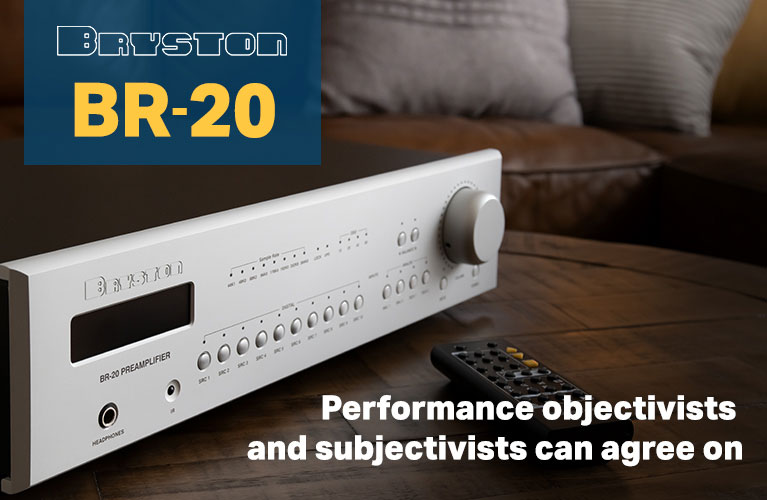Note: for the full suite of measurements from the SoundStage! Audio-Electronics Lab, click this link.
 Each of the websites that currently comprise the SoundStage! Network is devoted to a specific type of audio gear. SoundStage! Access covers home-theater and affordable two-channel hi-fi products, while SoundStage! Ultra is exclusive to two-channel hi-fi products, usually the esoteric and often the expensive; SoundStage! Simplifi focuses on convenience and lifestyle audio products of any price, and SoundStage! Solo reports only on headphones, earphones, and accessories; and so on.
Each of the websites that currently comprise the SoundStage! Network is devoted to a specific type of audio gear. SoundStage! Access covers home-theater and affordable two-channel hi-fi products, while SoundStage! Ultra is exclusive to two-channel hi-fi products, usually the esoteric and often the expensive; SoundStage! Simplifi focuses on convenience and lifestyle audio products of any price, and SoundStage! Solo reports only on headphones, earphones, and accessories; and so on.
This site, SoundStage! Hi-Fi, is restricted to two-channel hi-fi gear, but unlike Access and Ultra, we review stereo components of any price, from the low hundreds of dollars to the subject of this month’s review: Karan Acoustics’ Master Collection LINEb preamplifier ($28,000, all prices USD). Karan is in Serbia, an unexpected home base for a high-end audio manufacturer. In the more than 25 years I’ve been reviewing audio, Serbia has never been known as a hotbed of manufacturers making products at such high-end prices. The LINEb could change that.
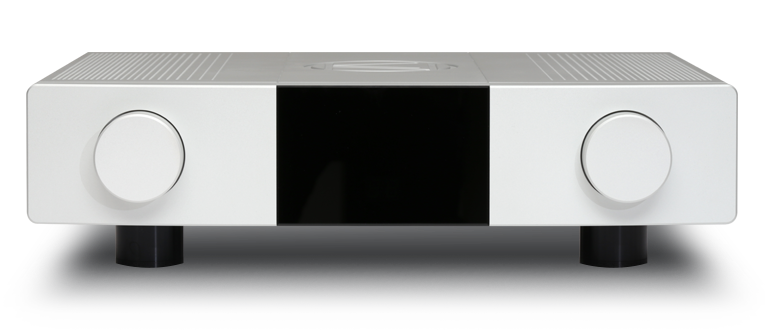
Description
The Master Collection LINEb is not Karan’s costliest model—that slot is reserved for the model on which it’s based: the two-box, Master Collection LINEa preamp with PSUa power supply ($41,000). Karan claims that the two models, both launched in celebration of the company’s 30th anniversary, in 2020, function identically. The LINEa and LINEb are minimalist designs, with few features—they let you select the input and adjust the volume, and that’s about it.
As I removed the LINEb from its wooden shipping crate, I found its size, weight, and solidity pretty impressive. The LINEb, at 19.8″W x 5.1″H x 15.3″D, is a big preamp. By comparison, the LINEa has the same width and depth as the LINEb but is twice as high when the LINEa preamp is stacked on top of the PSUa power supply. The LINEb’s 5.1″ height includes its three tallish feet, made by Critical Mass Systems, of the US, and the depth includes the front-panel knobs and rear-panel connectors; otherwise, the case measures 19.8″W x 3.75″H x 14.5″D. And at 38.4 pounds, the LINEb is damned heavy for a preamp.
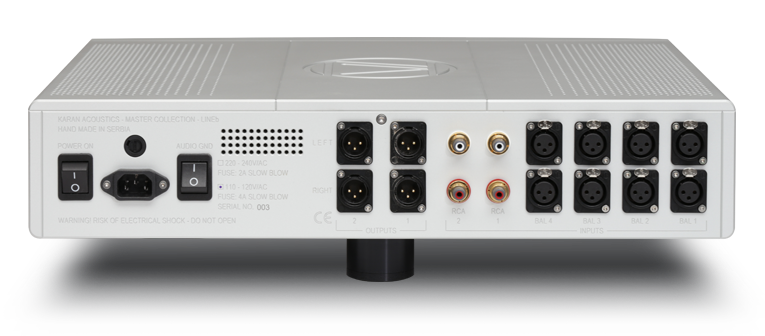
In fact, the LINEb’s size was a bit troublesome—it was the first preamp I’ve had here that was too wide to fit on a shelf of my equipment rack, which accepts components up to only 19″W. I had to move my turntable off the top of the rack—I didn’t need it for this review—and put the LINEb there.
Impressed as I was by the LINEb’s size and weight, what most impressed me about its construction was its build quality. The thick aluminum top, side, rear, and front panels of my review sample were machined as perfectly as I’ve seen anywhere—the joins fit ideally, and the panels’ fine texture looked perfect and felt just right to my hand. The fine metalwork includes a big Karan Acoustics logo carved into the center of the top panel, and the hundreds of ventilation holes drilled in an attractive pattern through that top plate to left and right of the logo. In ultra-high-end audio, companies such as Boulder Amplifiers, EMM Labs, MSB Technology, Vitus Audio, and a few others routinely earn praise for the quality of workmanship of their aluminum enclosures. Karan Acoustics can be added to that list—the quality on display in the LINEb gives up nothing to those brands, or any others.
The front panel, which varies in thickness from 0.875″ at the edges to 1.25″ at the center, has two big knobs of solid aluminum, each 2.375″ in diameter: Input on the left, and Volume/Mute on the right. When turned, the latter adjusts the volume; when pressed, it acts as a muting toggle, quickly ramping the volume down to silence, then up to the previous level when pressed again. Between these knobs is a 5.875″W screen that runs the full height of the panel. The screen displays, in bright, richly red characters on black, Karan’s name and logo, the input selected, the volume level (0-64), and the polarity: Phase (0°) or Rev (180°).
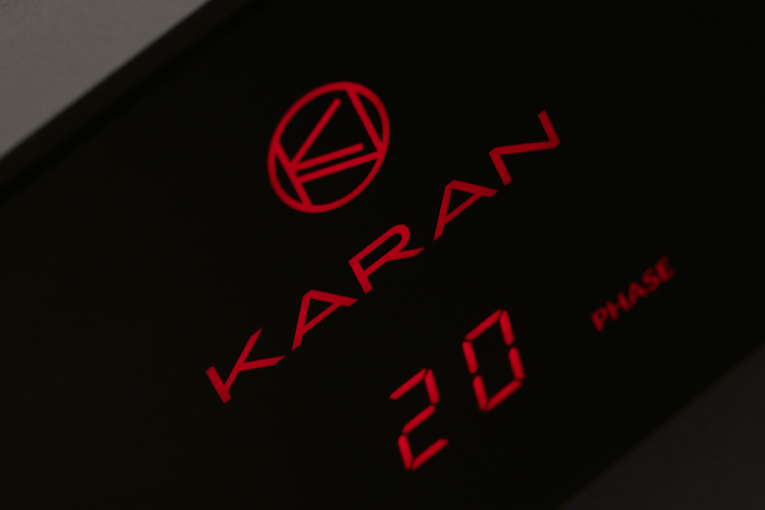
Commensurate with the LINEb’s size and solidity, its chunky knobs have the right feel when you turn them. They also make sounds when turned: the input selector emits a thunk with each change of input, the volume control a quieter, higher-frequency sound that’s not quite a chirp and that I think has something to do with the relays comprising the volume control. Using these controls during the weeks of my listening sessions, I came to appreciate and enjoy the sounds and feel of these controls. They made me realize that designer Milan Karan had put a lot of thought into pretty much every aspect of this preamplifier’s design.
Karan’s thoughtfulness seems to have extended to the remote control: a handsome disc of machined aluminum that, at 3.125″ in diameter and 1.125″ thick, is slightly wider and thicker than a regulation hockey puck. Colored and textured like the LINEb itself, it’s gently concave on the top and bottom. On top are four buttons: volume up and down, and toggles for polarity and mute. All that’s missing is an input button.
My single serious gripe about the LINEb has to do with its volume control. I can’t fault it for quality—it operates quickly and reliably, using what Karan says are “ultra-fast relays and custom made, non-magnetic resistors (0.1% tolerance)”—but for its 1dB increment of adjustment. While that will be fine enough for many people, some, like me, are used to setting the volume more precisely. EMM Labs’ Pre preamplifier ($25,000), a sample of which I have, works in 0.5dB increments, while those who want the ultimate in fine-tuning might prefer something like Simaudio’s Moon Evolution 740P preamplifier ($9500), whose level can be adjusted to within 0.1dB, at least within part of its volume range. When I asked Milan Karan about that, he said that he felt most people could make do with 1dB, and that it was “not necessary to make 0.5dB steps and complicate the attenuator with more components, because that would degrade the sound quality, and that is most important to me!”
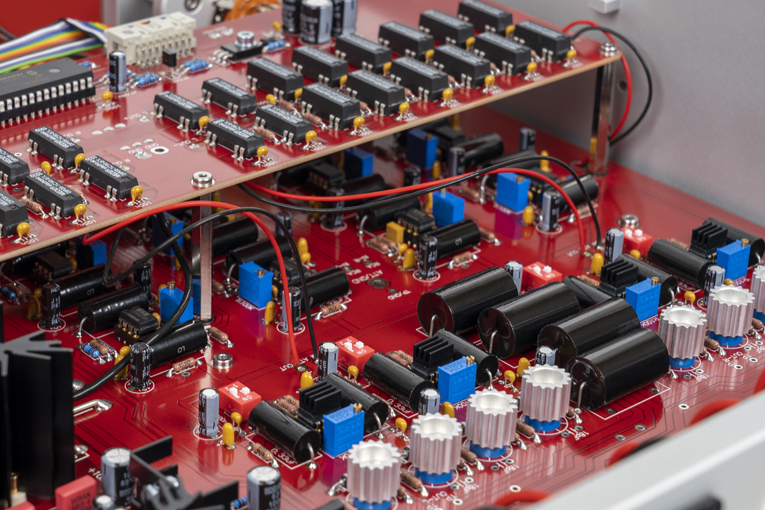
But on the LINEb’s rear panel I found nothing to complain about. From right to left, spaced out nicely, are four pairs of balanced inputs (XLR), two pairs of single-ended inputs (RCA), two pairs of balanced outputs (XLR), an on/off Audio Ground rocker switch for defeating the chassis ground if needed (I didn’t), an IEC power-cord inlet, and a main Power On rocker. In a nice touch, the labels for all connectors and switches are not silkscreened but actually incised into the plate.
Some might find the lack of single-ended outputs a problem, but not I—all of my amps have balanced inputs. Karan does this because the LINEb’s circuitry is fully balanced from input to output: “Our fully complementary design topology with smallest possible tolerances ensure the perfect balance between the positive and negative audio signal yielding absolutely identical amount of any distortion, noise or interferences that could arise on both signal polarities. Perfect balance of this kind mutually cancels all the unwanted signal by-products, leaving just the purest audio to reach our ears.”
Other specifications: The LINEb provides 6dB of overall gain, internally adjustable to 9dB. I talked to Karan about this; he said that he prefers 6dB and feels that it’s suitable for most systems. The LINEb’s circuits are not only balanced but class-A throughout, with an exceptionally wide frequency response of 1.5Hz-3MHz, -3dB (or 20Hz-20kHz, ±0dB). Karan believes this very wide bandwidth is important “to reproduce all high and low harmonics of fundamental tones (without delay, phase instability and amplitude), often outside the top and bottom extremes of the audio spectrum. Without the correct reproduction of all those harmonics, it is not possible to reproduce precise and accurate tonality and intonation of any musical instrument!”
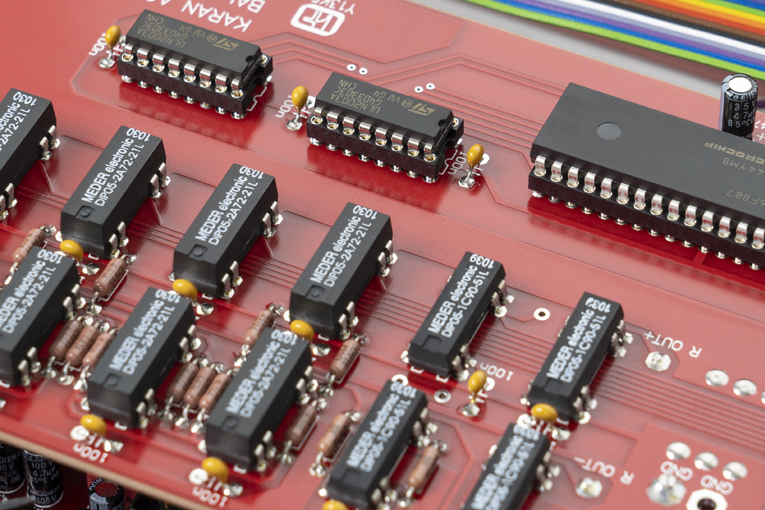
Karan Acoustics states that the LINEb has “nine (9) stages of current-voltage filtration and regulation per channel, as well as separate supplies for each audio channel (separate transformers and regulation circuits),” and that the “digital circuits, input selection and illuminated displays have their own, dedicated, separate transformers, regulation and filtration.”
Sound
The associated equipment used for this review were a selection of my staples: an Asus Zenbook UX303U laptop computer running Windows 10 and Roon connected to an EMM Labs DA2 V2 DAC via a Shunyata Research Alpha USB link, with Crystal Cable Standard Diamond balanced interconnects from DAC to preamp and preamp to amp(s); Revel Ultima2 Salon2 loudspeakers with QED Supremus speaker cables; two Shunyata Research Venom PS8 power distributors (one each for the source and amplification components); and an assortment of Shunyata Research power cords—Venom HC to the Venom PS8s, Venom HC to the LINEb, Alpha NR to the DA2 V2, and E-Tron Alpha HC to the various power amps I used.
I first used the Master Collection LINEb with Purifi Audio’s Eigentakt stereo amplifier, which I wrote about in June. Unlike the other amps I used, the Eigentakt isn’t commercially available; however, Purifi made available a limited number of test units to demonstrate their class-D amp technology. Those other amplifiers were pairs of monoblocks: Constellation Audio’s Revelation Taurus Monos and JE Audio’s VM60s. The 500W Taurus Mono is solid-state; the 60W VM60 is tubed (both power outputs into 8 ohms).
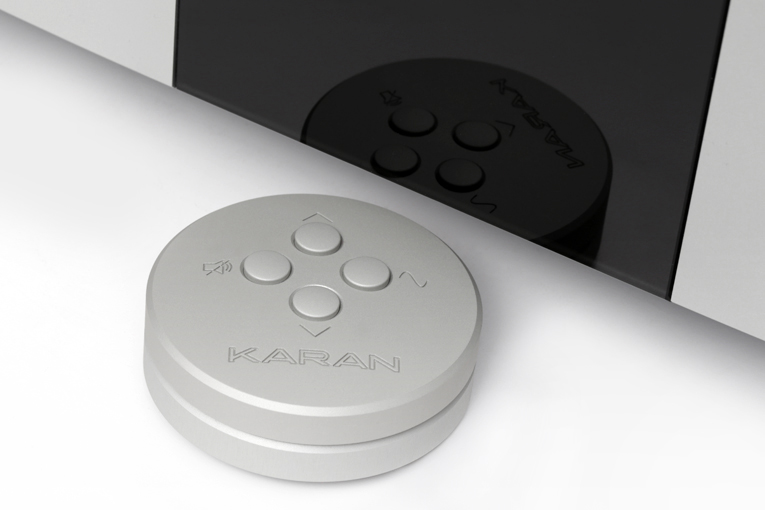
The Eigentakt’s total gain of 27dB is a bit less than the 28 or 29dB offered by most power amps, but that didn’t present a problem with the LINEb. According to the LINEb’s display, the volume level remained within 20-30 for much of my listening, and never exceeded 40, even at the loudest levels I tried.
Because the Eigentakt pretty much represents the state of the art in terms of low levels of distortion and low noise, it made for a good first test of just how quiet the LINEb might be. And it was quiet. When I turned the Karan’s volume knob all the way up to 64 with no music playing, then put one ear close to one Revel’s tweeter, I could hear only the tiniest hiss—on a par with what I hear from the Simaudio Moon Evolution 740P and EMM Labs Pre, which are extremely quiet preamps.
I next played a wide variety of music I know well, to get a feel for the LINEb’s overall sound. I wasn’t surprised to hear nothing but good qualities: extremely deep bass when the recording contained it, fully extended highs ditto, and an utterly clean and neutral sound at those extremes of the audioband and everywhere between. But getting a preamp to neutrally reproduce sound from the lowest lows to the highest highs isn’t all that hard—plenty of preamps that cost less than the Karan can provide sound just as neutral. What few of those preamps can do as well as the LINEb is reproduce recordings with well-captured soundstages—such as “Birmingham Shadows,” from Bruce Cockburn’s The Charity of Night (16-bit/44.1kHz WAV, True North). The positionings of Cockburn’s voice front and center on the stage as he sometimes speaks, sometimes sings; of his guitar, pretty much right at the left speaker; of Gary Craig’s drum kit about 10′ back and off to the left; and of Rob Wasserman’s double bass toward the back of the stage to the right—each instrument and voice was not only exceptionally well defined in space and rock-solid in its position, but there was a sense of space and “air” around each that I don’t recall having heard before with this recording. That’s not to say that it wasn’t there with my other preamps in the system, but for whatever reason, when I listened to this track through the LINEb, that spaciousness jumped out. The LINEb practically screamed high resolution—it reproduced every detail of the recording while adding no coloration of its own.
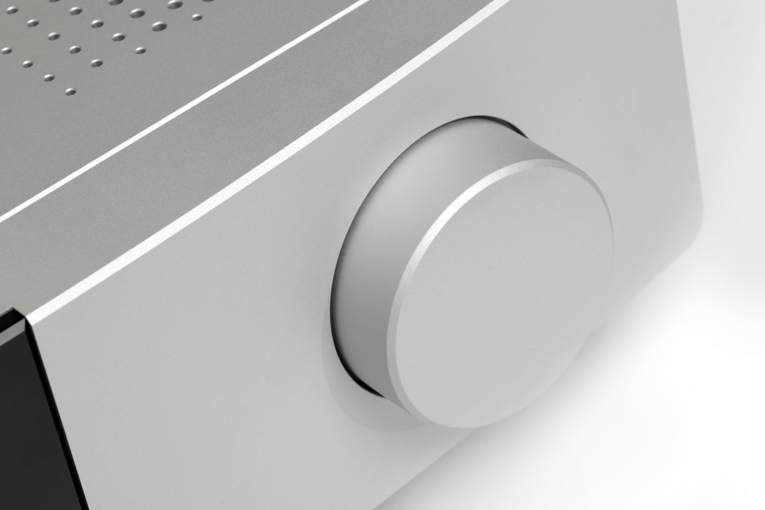
Similarly, when I repeatedly played all of the Cowboy Junkies’ The Caution Horses (16/44.1 WAV, RCA), I heard the same precision of aural imaging, soundstaging, and spaciousness as previously unheard minute details sprang to life. I found myself fixating on drummer Peter Timmins’s repeated rim shots in “’Cause Cheap Is How I Feel.” It’s not that I hadn’t heard them before, but what stood out this time was just how woody was the sound of his stick striking the drum’s metal rim, and how precisely it was positioned on the stage: 5′ behind and 4′ to the left of lead singer Margo Timmins’s voice, at front center on the stage. It had me wondering: Through my other preamps, has it always sounded like that? Has it always been so precisely placed?
To try to answer those questions, I swapped in the EMM Labs Pre and matched the two preamps’ levels. With the EMM, Peter’s rim shots were just as precisely positioned in relation to his sister’s voice, but both sounds seemed moved about 1′ forward. I also thought that Margo’s sibilants were slightly more apparent through the Pre, though the difference was very small. As for the sound of Peter’s stick, it was a very close call, but I came away convinced that its woodiness was more apparent through the LINEb. And that was a very good thing—it sounded more real.
I again played Cockburn’s “Birmingham Shadows,” switching between preamps multiple times and listening for everything already outlined in the three paragraphs above. The positions of aural images relative to each other on the stage remained the same through both preamps, but with the Pre, everything seemed a touch farther forward. The LINEb’s sound also had a bit more midrange body or richness, which I could hear in Cockburn’s voice and was perhaps why the LINEb produced a woodier sound with Peter Timmins’s rim shots. This greater midrange body surprised me—to my ears, the Pre had always had a bit more of this quality than the Simaudio 740P, which can sound a bit thin; my only criticism of it. Without question, I loved the LINEb’s sound—and these differences between preamps were subtle.
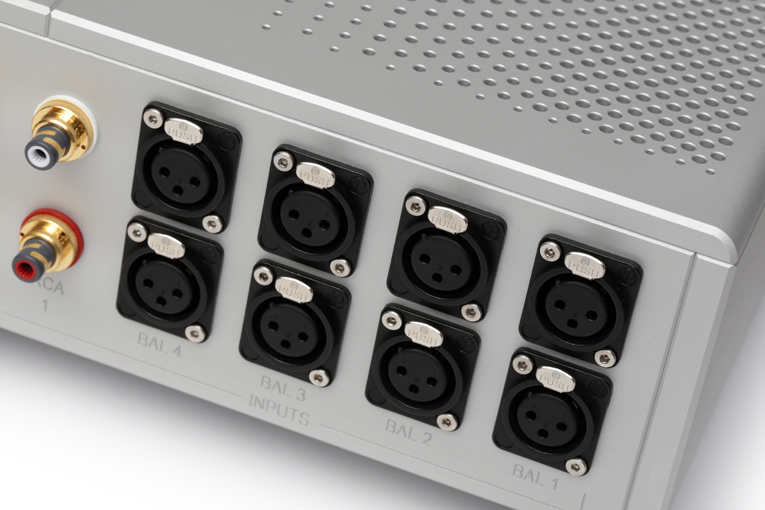
When I replaced the Purifi with the Constellation Audio Taurus Monos, the audible differences were still small, but greater than what I’d heard between the LINEb and Pre. The gain through the Tauruses’ standard balanced inputs is 25.2dB—even lower than the Purifi’s 27dB—but the LINEb’s default gain of 6dB was enough to get my Revel speakers to produce the volume levels I needed with plenty of headroom to spare. And again, with the volume at 64, no music playing, and an ear pressed to a tweeter, the LINEb was as quiet as I’ve heard.
With this setup, the most obvious differences were at the extremes of the audioband: The Constellation Tauruses’ bass was a bit more warm and blooming than the Purifi Eigentakt’s super-tight bottom, and the Tauruses’ highs weren’t as lively. The latter difference was most obvious to me when I played a high-resolution remastering of Bruce Springsteen’s Nebraska (24/192 FLAC, Columbia), which is the version of this album to have. The harmonica that begins the title track didn’t have quite as much immediacy or air through the Constellations as through the Purifi.
Over the following days I listened to myriad tracks through the Taurus Monos, including ones I’d listened to through the Eigentakt, and concluded that while switching to the Tauruses was a big step up in power (each Mono is specified to output 500W into 8 ohms, compared to the Eigentakt’s 200Wpc), there was no increase in resolution. The soundstages presented were of pretty much the same size, the image specificity was just as solid, and details were equally easy to hear. To the LINEb’s credit, in terms of resolution I’d never heard my system sound as good with the Purifi or the Tauruses—how deeply I could hear into my recordings was incredible. Anyone who wants to partner the LINEb with a traditional solid-state amp—the kind that Constellation Audio and others make—need not hesitate. The Karan worked as well with the Constellations as it did with the Purifi—and that was very well indeed.
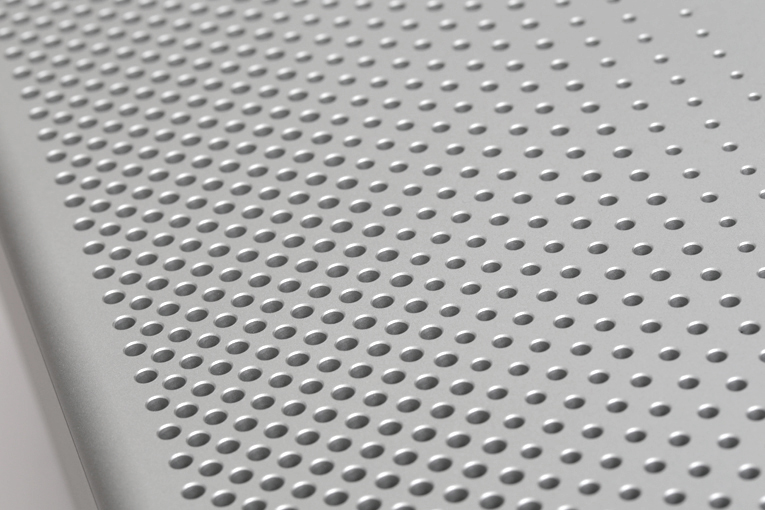
I next tried JE Audio’s VM60 tubed monoblocks. We’ve never measured the VM60’s gain, and JEA doesn’t specify it, but based on comparisons I’ve done with my other amps, I believe it’s around 30dB through its balanced inputs. That higher gain has, in the past, amplified noise from other preamps to the point that I could easily hear it, along with the VM60s’ higher level of self-noise, mostly due to their tubes. But turning the LINEb’s volume all the way up with no music playing and with ear to tweeter, I heard no more noise than I’d heard with no preamp in the signal path. Once more, the LINEb’s 6dB of gain proved sufficient.
With music, I was surprised to hear how well the VM60s could drive my Revels through the amps’ 4-ohm taps: There were ample bass, supersweet highs, and a beautifully developed and rich midrange, that last being why I keep these wonderful-sounding monoblocks around, despite their relatively high level of noise. There’s something glorious about the sounds of voices and instruments through them—and voices and instruments mostly live in the midrange.
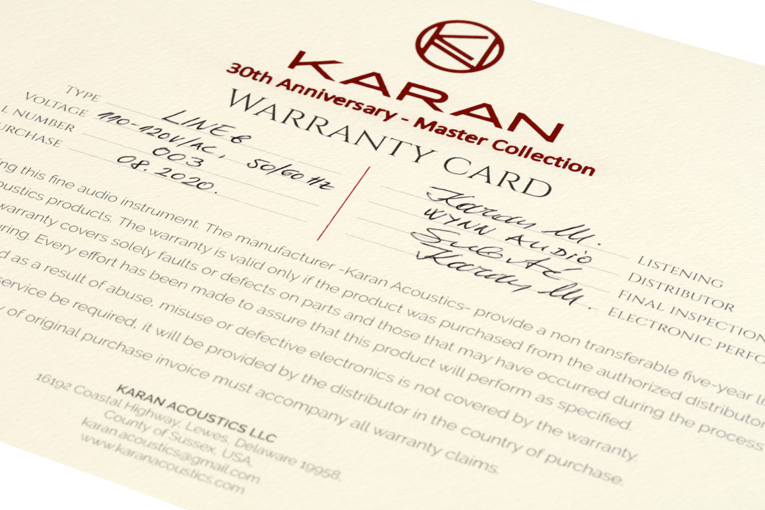
Playing Cockburn’s “Birmingham Shadows” and other tracks, I experienced a loss of detail compared to what I’d heard through the Eigentakt and Tauruses, which I attribute to the VM60s’ tubed circuitry—but the width, depth, and precision of soundstaging that the LINEb had supplied with those amps was still there, and the amount of musical detail I could hear was the best I’ve ever experienced with the JE Audios. As it had with the other amps, the LINEb proved to be a perfect partner for these tubed monoblocks.
Conclusion
Budget-minded readers who frequent SoundStage! Access and/or SoundStage! Hi-Fi might balk at the idea of a $28,000 preamplifier, wondering how in hell such a thing can cost so much, and who can afford it. Similarly, convenience- and lifestyle-oriented readers of SoundStage! Simplifi might question why something can cost so much and be so big while offering so few functions and features.
But to many readers of SoundStage! Ultra and SoundStage! Hi-Fi, the notion of a minimalist, cost-no-object, two-channel preamp is old hat. It’s those folks who need to know that Karan Acoustics’ Master Collection LINEb is one of the very best preamplifiers now available at any price.
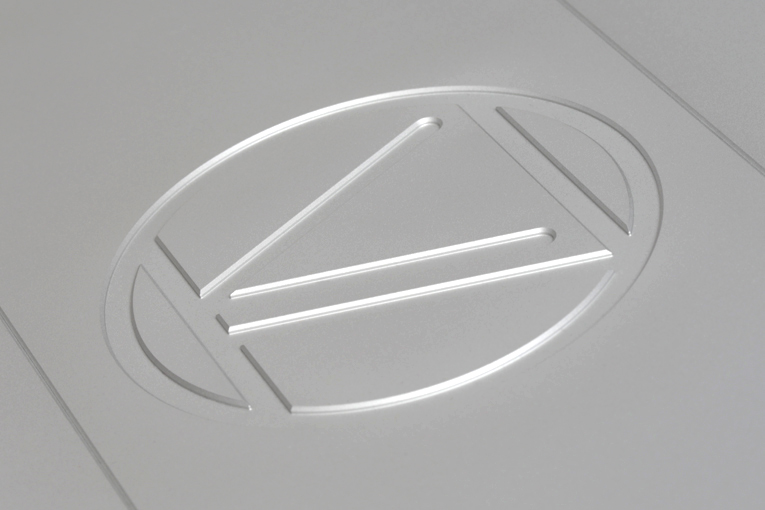
From its extraordinary build quality, to its noiseless operation and extremely high-resolution sound, to its stellar performance on the test bench, which reveals that what I heard can be largely if not entirely attributed to excellent engineering and execution (note that our measurements are done after listening), to its compatibility with the various power amps I hooked it up to, I have no criticism of the LINEb—other than wishing it offered finer volume adjustment than increments of 1dB. The Master Collection LINEb is of reference caliber, and impressive enough to firmly plant the Republic of Serbia on the high-end hi-fi map. In fact, on the strengths of this model, if Karan Acoustics decided to rename the Master Collection the Masterpiece Collection, I’d understand why.
. . . Doug Schneider
das@soundstagenetwork.com
Note: for the full suite of measurements from the SoundStage! Audio-Electronics Lab, click this link.
Associated Equipment
- Speakers: Revel Ultima2 Salon2
- Preamplifiers: EMM Labs Pre, Simaudio Moon Evolution 740P
- Power amplifiers: Constellation Audio Taurus Mono (monoblocks), JE Audio VM60 (monoblocks), Purifi Audio Eigentakt (demonstration unit, not commercially available)
- Digital-to-analog converter: EMM Labs DA2 V2
- Computer: Asus Zenbook UX303U laptop computer running Windows 10, Roon, Tidal, Qobuz
- Digital link: Shunyata Research Alpha (USB)
- Analog interconnects: Crystal Cable Standard Diamond balanced (XLR)
- Speaker cables: QED Supremus
- Power distributor/conditioner: Shunyata Research Venom PS8 with Defender (2)
- Power cords: Shunyata Research: Alpha NR, E-Tron Alpha HC, Venom HC
Karan Acoustics Master Collection LINEb Preamplifier
Price: $28,000 USD.
Warranty: Five years parts and labor.
Karan Acoustics
Danila Kisa 5
21000 Novi Sad
Serbia
Phone: +381 63 507 729
E-mail: karan.acoustics@gmail.com
Website: www.karanacoustics.com
North American distributor:
Wynn Audio
Unit 31, 20 Wertheim Court
Richmond Hill, Ontario L4B 3A8
Canada
Phone: (732) 683-2356
E-mail: info@wynnaudio.com
Website: www.wynnaudio.com






















